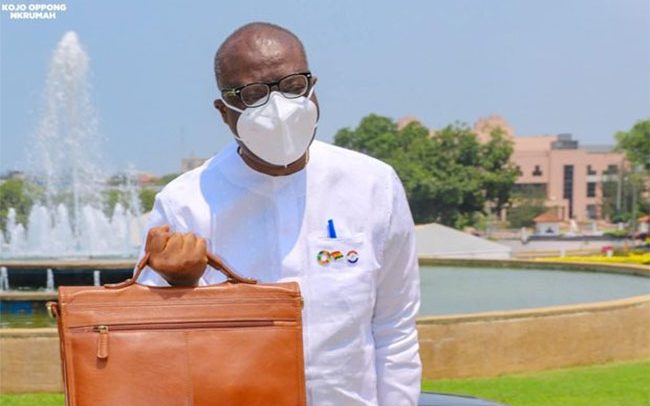Ken Ofori-Atta
GHANA IS targeting an overall economic growth of 5.8% in 2022, short than the 6.2% forecasted by the International Monetary Fund (IMF).
According to Finance Minister Ken Ofori-Atta, who presented the 2022 budget and economic policy to Parliament yesterday, this was based on the macroeconomic objectives and the medium- term targets set for 2022.
He said non-oil real GDP growth is expected to be 5.9%, while the end of year inflation rate is pegged at 8% with a fiscal deficit of 7.4%.
Additionally, he projected a primary surplus of 0.1 percent of GDP and Gross International Reserves (GIR) to cover not less than 4 months of imports.
While the World Bank is forecasting a 5.5% growth in the economy in 2022, suggesting strong growth in exports, Ghana’s target appears slightly high.
The new projection also is bigger than the 3.8% that the IMF has projected for Sub-Saharan Africa for 2022, contained in the October 2021 Regional Economic Outlook for Sub-Saharan Africa, titled “One Planet, Two Worlds, Three Stories.”
Revenue Mobilisation
The Minister continued “Mr. Speaker, Total Revenue and Grants for 2022 is projected to rise to GH¢100.5 billion, equivalent to 20.0 percent of GDP, up from a projected outturn of GH¢70.3 billion, equivalent to 16.0 percent of GDP for 2021. Domestic Revenue is estimated at GH¢99.5 billion and represents an annual growth of 44.0 percent over the projected outturn for 2021.”
Resource Allocation
Total expenditure (including clearance of Arrears) is projected at GH¢137.5 billion, equivalent to 27.4 percent of GDP. The estimate for 2022 represents a growth of 23.2 percent above the projected outturn of GH¢111.6 billion, equivalent to 25.3 percent of GDP for 2021.
The key drivers of expenditure growth include Capital Expenditure, funding of key Government flagship programmes, wage bill, and interest payments.
Based on the estimates for Total Revenue & Grants and Total Expenditure, the 2022 fiscal operations will result in an overall fiscal deficit of GH¢37.0 billion, equivalent to 7.4 percent of GDP. This includes the financial sector and energy sector IPPs payments. It also represents a nominal year-on-year reduction of about 30.7 percent over the projected outturn of 12.1 percent of GDP in 2021.
The corresponding primary surplus of GH¢435 million, equivalent to 0.1 percent of GDP, is also projected for the year.
“The signalling is clear. We are going to judiciously work our way out of our debt situation.”
He continued that total foreign financing of the deficit as well as exceptional financing, namely the IMF’s Special Drawing Rights (SDR), will amount to GH¢9.1 billion, equivalent to 1.8 percent of GDP and will include a planned international financing programme (not to exceed $1 billion) to raise up to $750 million for liability management and budget support, particularly, capital expenditure.
On the other hand, he said financing of the deficit from domestic sources, including net issuances from debt will amount to GH¢27.9 billion, equivalent to 5.6 percent of GDP.
The additional exceptional financing from the utilisation of the newly allocated SDRs by the IMF will augment and reduce domestic borrowing needs.
“As a country we still rely heavily on debt financing to meet a significant portion of our expenditures compared to our peers. It is instructive to note that, on the expenditure side, for instance, interest payments and compensation payments alone amounted to GH¢48.7 billion which is 103.3% of total revenue and grants for Jan-Sept, 2021. In fact, these two expenditure items absorb all the revenue collected for the period. This trend must be reversed,” he noted.
BY Samuel Boadi


